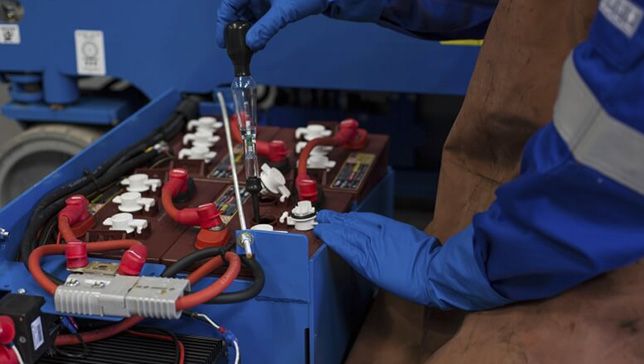Batteries are the lifeblood of electric booms and scissor lifts. A well maintained battery can yield up to three times longer equipment life.
A battery pack not showing a full charge after being plugged in overnight or a machine running out of power well before the end of a workday are red flags, indicating that some maintenance or replacement of the batteries is required.
Following these service tips will help you to maximize battery life in your electric boom and scissor lift machines.
REGULAR BATTERY MAINTENANCE
Check out this brief video to learn about regular battery maintenance tasks for aerial lifts.
Here’s a breakdown of what you just watched:
- Remove rubber grommets and ensure the battery posts are corrosion-free and battery cables are clean and tight. Anything that gets in the way of a secure connection between the cable and posts can reduce the battery’s performance and machine function on the job.
- Remove filler caps and top-off batteries. During regular machine use and charging cycles, the fluid level (acid/water mix) will drop, reducing battery performance and the length of operation between charges. Use only distilled water for this procedure, not tap water, as tap water contains minerals that will reduce battery capacity and increase the self-discharge rate. It’s also a good practice to check the acid levels at this time using a hydrometer.
LONG-TERM BATTERY MAINTENANCE
- Clean battery banks to remove excess dirt and debris: Ensure the batteries stay dry and clean. Otherwise, surface discharge can occur, leading to reduced operating times between charges for both electric booms and scissor lifts.
- Run an amp-draw test: Utilize a high-quality digital or carbon pile battery tester to confirm that each battery operates within its recommended specifications. The average auto parts load tester typically pulls about 40-60 amps, which is not enough for even small machine batteries. Smaller booms and scissor lifts generally have four 6V batteries, while larger machines will include a bank of eight 6V batteries.
- Perform a charge test by plugging in the battery charger: Verify that all the batteries are charging and replace bad batteries. Ensuring that each battery is functioning will avoid the need to replace the battery on-site.
Following the above maintenance procedures will significantly extend the battery’s service life. A poorly maintained battery may need to be replaced within one year, whereas the well maintained battery can last as long as three years.
Content provided by Genie – a Terex brand.
[thrive_leads id=’7326′]
